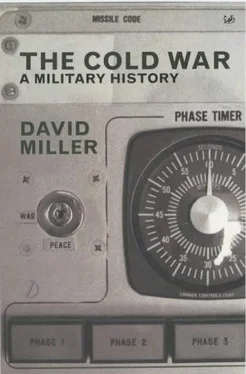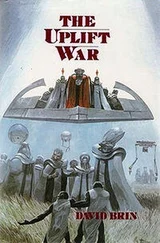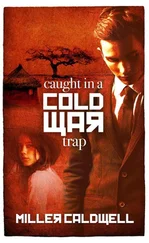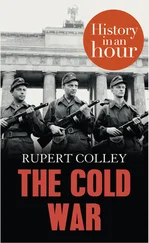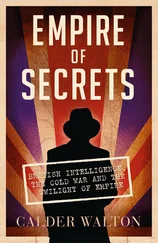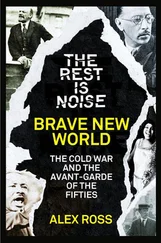Another outcome of the Chief-of-Staff Committee’s work was the creation of the Western Union Defence Organization, a permanent planning and liaison organization, which officially started work on 3 October 1948 at Fontainebleau, France. It was headed by a Commanders-in-Chief Committee chaired by the most prestigious European soldier of the day, Britain’s Field Marshal Bernard Montgomery. The other members were:
• Commander-in-Chief Western Europe Land Forces – General Jean de Lattre de Tassigny (France);
• Commander-in-Chief Western Europe Air Forces – Air Chief Marshal Sir James Robb (UK);
• Flag Officer, Western Europe – Vice-Admiral Jaujard (France).
In this organization, Montgomery had two small headquarters: one in London, the other in Fontainebleau, where it sat alongside the land and air headquarters. The committee was not as powerful as appeared, however, since the land and air members became commanders-in-chief only in war, while, as was clear from his title, the ‘Flag Officer, Western Europe’ had no allocated naval forces. Montgomery’s position also gave rise to some problems, since he was not a supreme commander but simply the chairman of a committee, and in addition to this there was a personality clash with de Lattre de Tassigny, who, like Montgomery, was a man with firm views, not least concerning his own importance.
Despite its shortcomings, the organization was a start and the United States Joint Chiefs-of-Staff were so keen to be seen to support it that, in an unprecedented move, they sent two lieutenant-colonels to Fontainebleau to work with the new headquarters as ‘non-participating members’.
The Brussels Treaty had many deficiencies. Its terminology was imprecise, it did not contain an agreement to go to war automatically, nor did it give the commanders sufficient troops for the proposed tasks, and, most important of all, it did not directly involve the Americans. On the other hand, it had the important short-term benefit of demonstrating to the United States that western European countries were, at long last, prepared to co-operate and combine for the common good. It also proved to be of great utility in providing the political vehicle for the admission of West Germany to European defence in 1954. Above all, however, it proved to be the starting point for a much more significant agreement: the North Atlantic Treaty.
The seriousness of the position between East and West was emphasized when, on the day that the Brussels Treaty was signed, US president Harry S. Truman addressed a joint session of Congress. He declared the United States’ full support for the treaty, but he also requested Congress to authorize the reintroduction of selective service.
The end of the war had found the Soviet Union in possession of much of the Baltic littoral, including Estonia, Lithuania, Latvia and East Prussia, and in occupation of Poland and the eastern zone of Germany. The USSR had also occupied Finnmark, the northernmost Norwegian province, and the Danish-owned Baltic island of Bornholm in 1945, primarily in order to take the surrender of the German forces; both were, however, handed back peacefully, Finnmark in late 1945 and Bornholm in the spring of 1946.
Despite this, Denmark and Norway found themselves faced with a palpable Soviet threat in early 1948 and started to examine the question of a defence pact, although initially they considered only limited membership based on a ‘Nordic’ grouping. These countries wished to avoid becoming involved in the Great Power rivalry between the USA and the Soviet Union, and were also keen to avoid becoming embroiled in the tensions in continental Europe immediately to their south.
The most powerful and prosperous of the Nordic countries was Sweden, which had successfully maintained its armed neutrality throughout both world wars and wished to continue to do so. Thus, in the immediate post-war period Sweden performed a delicate balancing act, making a 1 billion kronor loan to the Soviet Union, but also purchasing 150 P-51 Mustang piston-engined fighters from the USA, followed by 210 Vampire jets from the UK in 1948.
Norway had been occupied by the Germans during the war, partly because of its strategic position, but also because German industry depended upon Norwegian iron-ore production. In the post-war period Norway considered the Soviet threat to be very real, and its leaders began to seek a guarantee of security which would nevertheless not antagonize the Soviet Union.
Denmark was initially well disposed towards the Soviet Union in the aftermath of the war, but became increasingly concerned by the events in eastern Europe. In the spring of 1948 the country was swept by a rumour that the Russians intended to attack western Europe during the Easter weekend. This rumour turned out to have been ill-founded, but the Danes realized that neutrality was no longer a serious option and that some form of multinational co-operation was therefore essential. During its Second World War occupation by the Germans, Denmark, unlike many other occupied countries in western Europe, had been almost totally isolated from the UK and had been forced to look to its neighbour Sweden for what little help and support that neutral country could offer. It was only natural, therefore, that in the late 1940s it should wish to explore the possibilities of an alliance with Sweden.
On 19 April 1948 the Norwegian foreign minister, Halvard Lange, made a speech in which he publicly expressed interest in a ‘Nordic’ solution – by which he meant one involving Denmark, Iceland, Norway and Sweden.
Finland would also have been a natural member of a Nordic grouping, but the USSR made that impossible. The peace treaty had imposed strict manpower ceilings on Finland’s armed forces [3] Finland was permitted 34,000 in the army, 4,000 in the navy, and 3,000 in the air force (including any naval air arm), while equipment limits included 10,000 tonnes of warships and sixty aircraft. Submarines and bombers were totally prohibited.
and, as if this was not enough, the country was effectively neutralized by the treaty of ‘Friendship, Co-operation and Mutual Assistance’ that the Soviet Union had forced it to sign on 6 April.
The Norwegian initiative was considered by the Swedish parliament, which authorized its government to consult Denmark and Norway on the subject. Throughout these discussions the basic Swedish position was that Sweden would not stretch its neutrality beyond a Nordic grouping, which would be non-aligned and strong enough to remain uncommitted to either East or West; in particular, Sweden was not prepared to participate if any other members had bilateral links to outside parties. On the other hand, the Norwegians considered that their interests would best be served by joining an Atlantic pact (i.e. one involving the United States), while the Danish prime minister sought to find common ground between the other two parties. Having established their initial positions, in September 1948 these three countries set up a Defence Committee whose task was to study the practical possibilities of defence co-operation.
At the political level, in October 1948 the Danish and Norwegian foreign ministers sounded out the US secretary of state, George Marshall, about the likely US attitude to a Nordic pact. He told them that it would be very difficult for the US government to give military guarantees to a neutral bloc, and that any supplies of military equipment would inevitably take lower priority than to formal allies.
In January 1949 the Nordic Defence Committee reported that a trilateral military alliance would increase the defensive power of the three participants both by widening their respective strategic areas and through the benefits of common planning and standardization of equipment. All this, however, could be achieved only if Denmark and Norway underwent substantial rearmament. And even if all of this were achieved, the military experts advized that the Nordic pact would be unable to resist an attack by a Great Power (by which, of course, they meant the Soviet Union).
Читать дальше
